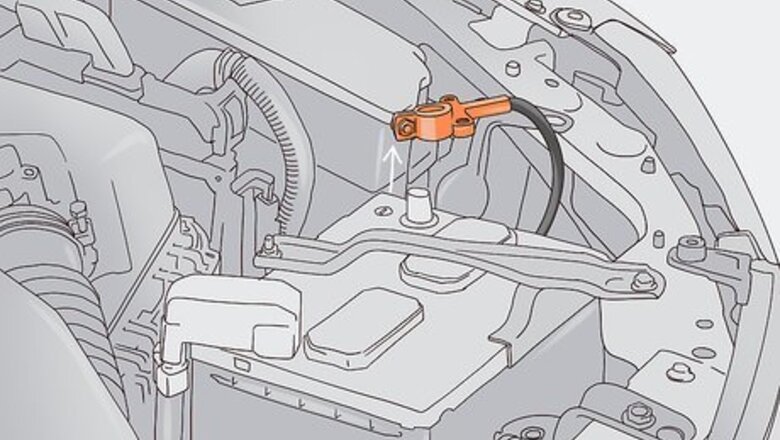
views
Mounting the Amp and Removing Panels
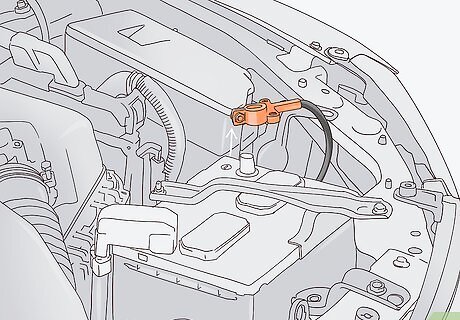
Disconnect the negative terminal on your vehicle’s battery. Open the hood of your vehicle and locate the battery near the front of the engine bay. Use a socket wrench to loosen the nut holding the negative terminal to the battery, which is usually black and marked with a negative symbol (-). Set the cable for the negative terminal aside while you’re working so it’s out of the way. Don’t touch the negative lead to the positive terminal since you could create a spark or shock yourself.Warning: Never work on your vehicle’s electrical system while the battery is still attached.
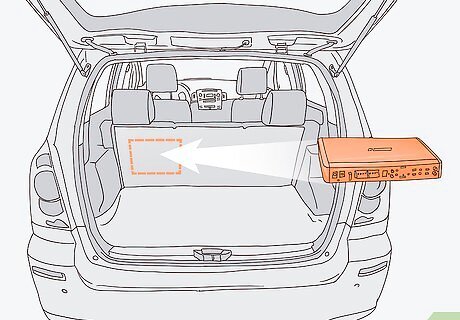
Mark the amp’s mounting holes on your vehicle’s floor where you want to mount it. Choose a place that has flat floors, such as your trunk, in the passenger seat footwell, or under the rear seats. Check underneath your vehicle to make sure there aren’t any wires or pipes on the other side of where you want the amp. Hold the amp still as you mark the locations of the mounting holes in the corners with a marker or pencil. Avoid mounting amps vertically or to speaker boxes since they may jostle around more and get damaged. Make sure the place where you want the amp has good airflow because the amp will generate heat that could damage the internal electronics if it gets too hot.
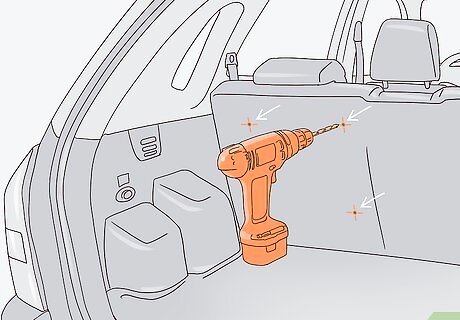
Drill holes through the floor where you marked them. Use a drill bit with a diameter ⁄8 inch (0.32 cm) smaller than the diameter of the mounting screws that came with your amplifier. Hold the drill perpendicular to your vehicle’s floor and pull the trigger. Apply light pressure as you drill through each of the marks you made for the mounting holes. You can drill directly through the carpeting in your vehicle.
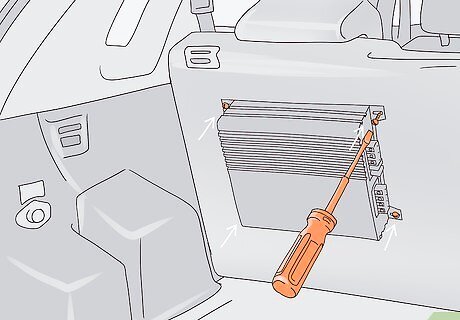
Screw the amp onto the floor with the screws from the amp kit. Position the amp so the mounting holes line up with the holes you just drilled. Feed a mounting screw into each of the holes and turn them by hand until they’re tight. Then use a screwdriver to tighten the amp to the floor so it doesn’t move around. If the mounting screws came with rubber washers, put them on the screws before securing the amp to prevent it from moving around. Don’t leave the amp unmounted since it will move around while you’re driving and get damaged.
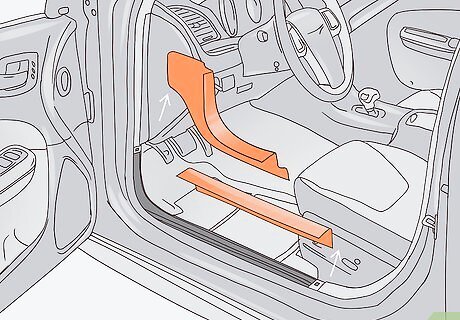
Remove the interior trim along the floor on both sides of the vehicle with a pry tool. A trim pry tool is a thin plastic piece you can slide underneath trim pieces to pop them off. Locate the trim panels along the sides of your vehicle on the floor and slide the pry tool underneath them. Raise the handle of the pry tool to pop the trim pieces off. Set them aside while you’re working so they’re out of the way. Buy pry tools from an automotive store. If you don’t want to remove the trim pieces, you can use the trim pry tool to push the wires underneath the panels instead.
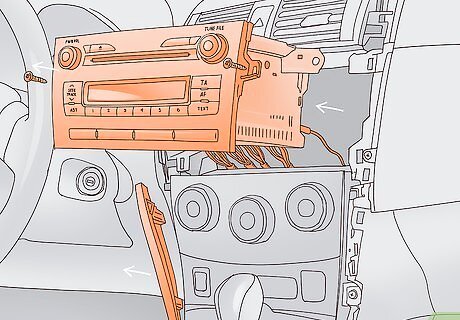
Take the stereo head out from the dashboard with a screwdriver. Slip the pry tool between the seams of the trim panels around your stereo system. Lift the handle of the tool to pop the trim off to expose the screws supporting the stereo head. Use a screwdriver to loosen the screws holding the stereo head before you pull it straight out from the dash so you can see the wire connections plugged into it. The number of panels you need to remove to take out the stereo head depends on the make and model of your vehicle.
Running the Wires
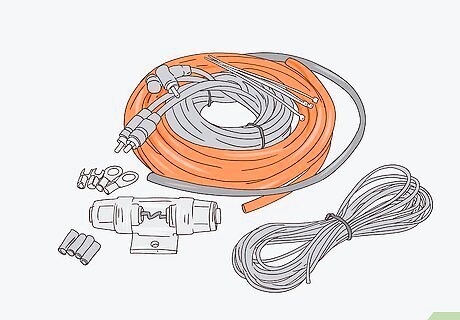
Buy an amp installation kit so you have all of the proper wires. Look at an automotive store to see what options they have for installation kits. Get a kit that has 8- or 10-gauge wiring so they can carry the full current without overheating and melting. Open the kit and separate all of the components so you can stay organized while you’re working. Installation kits usually cost around $15–20 USD. The installation kit will include a red power cable, black ground cable, blue remote wire, RCA cables, in-line fuse, and connectors for all of the wiring. It does not matter what kind of stereo you use the amplifier with. You can use the stock car stereo or use one that’s after-market.
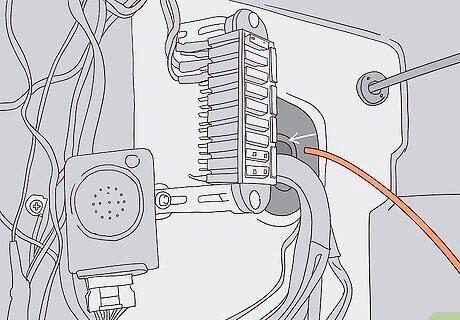
Find a hole in your vehicle’s firewall on the same side as the battery. Check the vehicle’s engine bay so you can see if the battery is on the driver or passenger side. Look in the footwell that’s on the same side as the battery to see if there’s a cutout in the firewall, which is the metal panel between the engine bay and interior. If there’s already one with wires coming through it, you can also feed the amp power cord through it. If you don’t see a hole in the firewall, use a drill bit made to bore through metal and create a new hole. Make sure there isn’t anything in the engine bay where you plan on drilling the hole.
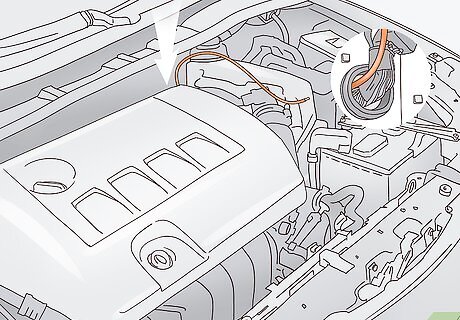
Feed the red power cord through the hole in the firewall. Start from the interior of your vehicle, and push the red cable through the middle of the hole. Feed about 4–5 inches (10–13 cm) of the cable before going to the engine bay and pulling it from the other side. Pull enough of the cable through so it reaches the battery. The color of the power cord may vary depending on the installation kit you purchased. The power cord is the only wire that goes through your vehicle’s firewall.
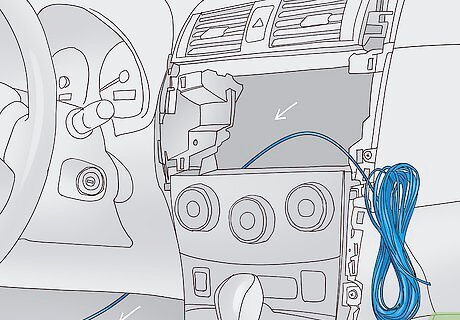
Pull a blue remote wire behind the stereo head so it comes out by the power cord. Find the thin blue wire from the installation kit, and feed one end through the hole in the dashboard behind the stereo. Push the wire down until you can see the end come out in the footwell. Line up the remote wire with the power cable so you can run them at the same time. The remote wire turns on the amplifier when your stereo starts so it doesn’t drain the battery. The remote wire may also be called the turn-on wire.
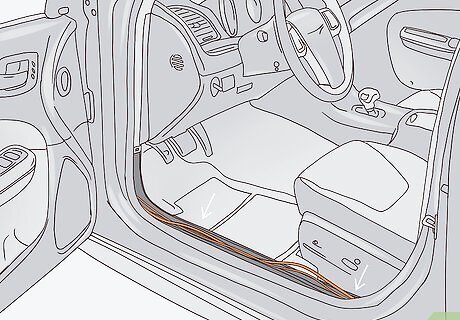
Tuck the power and remote wires on the floor along the sides of your vehicle. Position the wires so they run along the floor on the same side of the vehicle as the battery. Place the wires into the recesses that are normally covered with the trim pieces so they’re concealed later on. Run enough wire so the remote and power cables can easily reach the amplifier. Don’t pull the wires tight since you’re more likely to damage them. If you didn’t remove the trim pieces, use a pry tool to push the wires underneath the trim.Tip: Secure the power and remote cables every 6–8 inches (15–20 cm) with zip ties to the other wires under the trim if you don’t want them to move around.
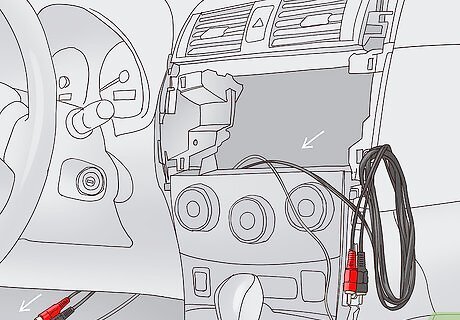
Run the RCA cable on the opposite side of the vehicle as the power. Look for the blue or silver cable that has red and white inputs on each end. Feed one end of the RCA cable through the hole in the dashboard behind the stereo system and push it through until you see it in the footwell. Run the cable along the side of your vehicle so it’s in the recesses normally covered by trim. Pull the cable so it can reach where you’ve mounted the amp. Don’t run the RCA cables on the same side as the power cable since you may pick up audio interference when you’re running the amplifier.
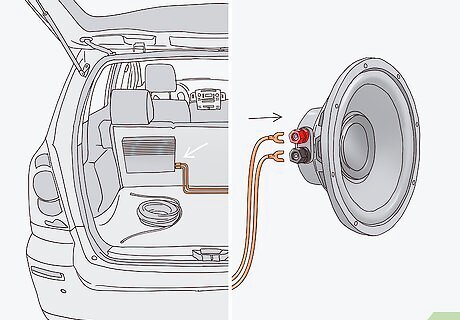
Connect speaker wires to each speaker you want hooked up to the amp. The number of speaker wires you run depends on how many speakers you want connected to the amp. Start the speaker wire near your amp and run it to the speaker you want to attach. Take out the old speaker wires from the ports before putting in the new ones in. Tighten any screws or fasteners that hold the speaker wires so they don’t pull out. Repeat the process for any other speakers you want to wire. You may need to remove additional trim pieces to hide speaker wires running through your vehicle. Your installation kit may or may not have speaker wires. If it doesn’t get a roll of speaker wire from your local hardware or electronics store.
Wiring the Amplifier
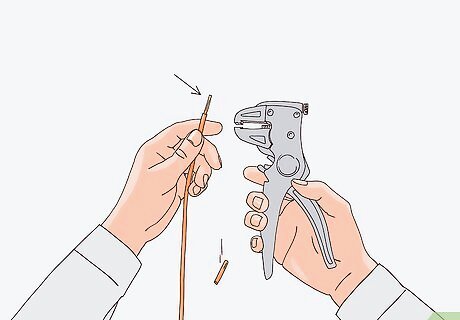
Strip ⁄2 in (1.3 cm) off the ends of every wire you ran. Grip the wire in the jaws of a wire stripper and close the handles together. Pull the stripper toward the end of the wire to cut off the insulation covering the copper wires. Be sure to strip ⁄2 inch (1.3 cm) of insulation from each end of the wire. Repeat the process with all of the other wires you’re connecting to your amp. Be careful not to cut or damage any of the wires, or else you may need to feed new ones through your vehicle.Variation: If you don’t have a wire stripper, carefully slice the insulation off with a utility knife.
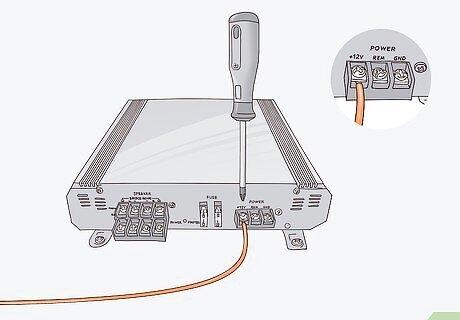
Push the power cable into the 12 V input on the amp. Locate the power input terminal on the back of the amp, which is usually labeled “+” or “12 V Power.” Push the exposed end of the cable into the terminal and tighten the screw so it doesn’t fall out. Give the cable a light tug to make sure it stays in place. Make sure none of the exposed wire sticks out from the amp since it could create a fire hazard.
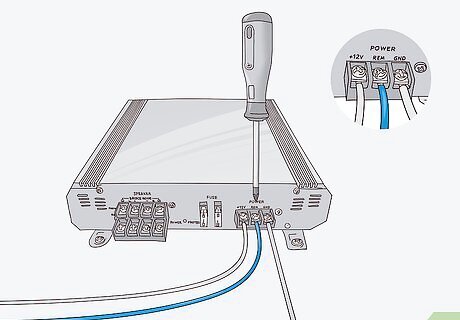
Secure an end of the black ground cable to the ground port. Look for a black cable in your installation kit used for grounding the amp. Push the exposed end of the cable into the terminal labeled “Ground” and tighten the screw with a screwdriver. Tug the cable lightly to make sure it doesn’t pull out of the terminal. The ground cable will allow the current to travel through the amp so it doesn’t shock you when you use it.
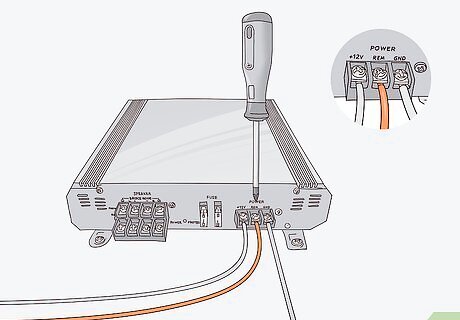
Attach the blue wire to the remote input port of the amplifier. Locate the terminal on the back of the amp that says “Remote” or “Turn-on” for the blue wire. Place the end of the blue wire into the terminal and screw it down so you can’t pull the wire out. Make sure none of the exposed wires sticks out from the terminal.
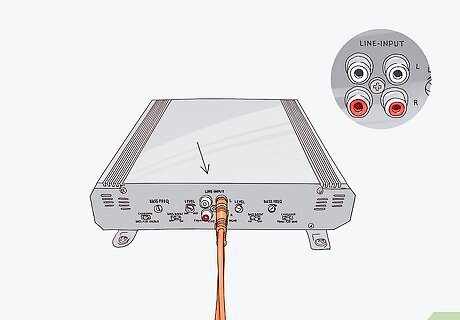
Plug in the RCA cable to the amp’s red and white inputs. Search for the input ports that have red and white circles around them to use for the RCA cable. Connect the red RCA lead to the red port and the white lead to the white port. Push the leads in as far as they can go to ensure they have a solid connection.
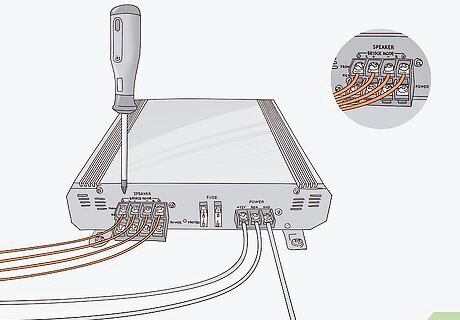
Feed the speaker wires into the input pins on the back of the amp. Locate the small ports on the side or back of the amp labeled “L” and “R.” Plug any speakers that are on the left side of your vehicle into the speaker ports labeled “L” and the speakers on the right in the “R” ports. Tighten the screws on the ports so they hold the speaker wires securely. There may be separate speaker ports for front and rear speakers, but it can vary depending on the amp.
Connecting the Amp to Power
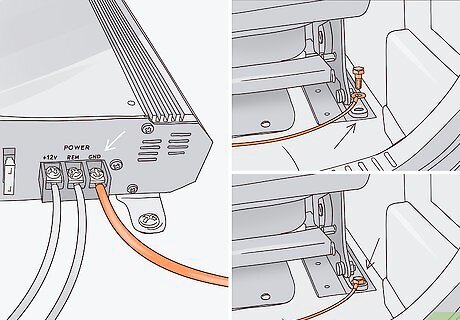
Connect the end of the ground cable to a bare metal bolt. Lift the carpet or trim near your amp and look for a bolt that has bare metal. Use the end of the ground cable that has a ring or bracket to attach to the bolt. Loosen the bolt with a socket wrench and pull it out. Line up the end of the cable with the hole before feeding the bolt through it. Tighten the bolt completely so the cable has solid contact with the metal. If there’s anything attached to the bolt, be sure to support its weight when you attach the cable so it doesn’t fall and break.Warning: Don’t attach the ground cable to a painted bolt, or else it will not work properly. If there’s paint on the bolt, clean it off with sandpaper first to expose the bare metal underneath.
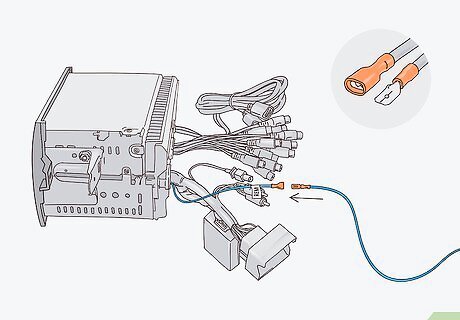
Secure the remote wire to the amp turn-on wire plugged into the stereo with a butt connector. Look for a blue wire with a white stripe that’s already attached to the back of your stereo, which is the turn-on wire. Leave the turn-on wire plugged into the stereo and remove ⁄2 inch (1.3 cm) of the insulation. Slide a butt connector, which is a small hollow tube that allows you to connect 2 wires, onto the end of the turn-on wire. Push the end of the remote wire into the other side of the butt connector. Crimp the middle of the connector with a wire crimper so it has a firm connection. The installation kit should come with butt connectors, but you can buy them at a hardware store if yours doesn’t.
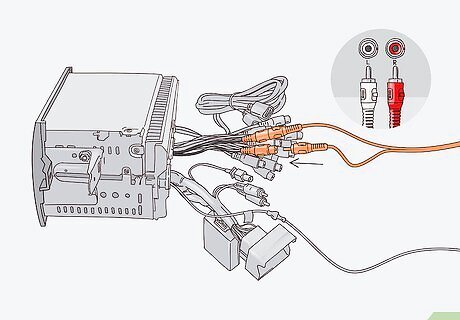
Plug the RCA cable into the matching ports on the back of the stereo head. Look for the white and red RCA ports on the back of your stereo system, which will look similar to the ports on the back of the amp. Plug the red lead from the cable into the port with the red circle, and use the white lead in the white port. Push the RCA cable in firmly so it has a solid connection. If your stereo doesn’t have RCA ports, then plug them into a line output converter, which changes the signal coming from your stereo. Follow the wiring diagram on the output converter to connect it to your stereo system before plugging the RCA cable into the ports.
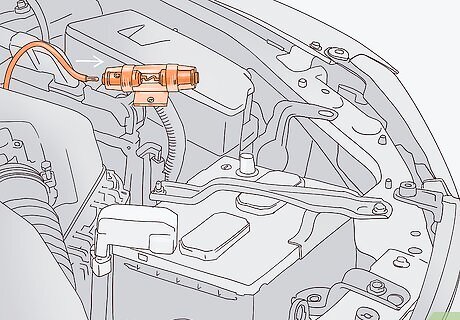
Attach an in-line 30-amp fuse to the end of the power cord by the battery. Your installation kit will come with a fuse and a fuse holder. Push one side of the fuse holder onto the end of the power cord inside the engine bay, and screw it in to secure it. Push the fuse inside of the holder until it clicks into place before closing it. Connect another piece of the red power cable to the other side of the fuse holder and tighten the screw. You can buy fuses and fuse holders from a hardware or automotive store if your installation kit didn’t have one. Don’t install an amp without a fuse, or else you could create a fire risk.
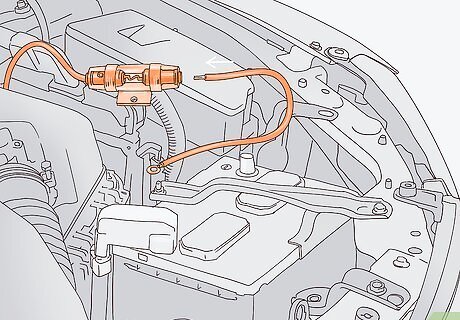
Crimp a ring terminal onto the power cord. A ring terminal has a circular end that you can easily slide over bolts to make connections. Place a 10-gauge ring terminal on the end of the power cable so the insulation sleeve covers the exposed wires. Grip the sleeve with a pair of wire crimpers, and squeeze the handles together to secure the terminal to the cable. Your installation kit will come with ring terminals, but you can buy them at automotive or electronics stores if you need to.
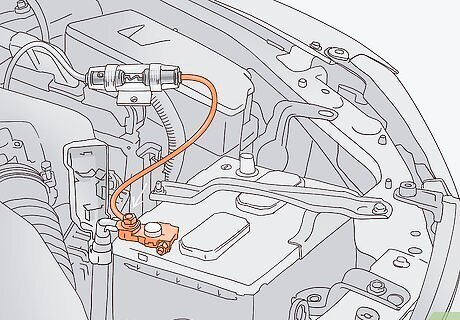
Put the power cord on the positive terminal of the battery. Loosen the positive terminal on the battery with a socket wrench so you can pull it off. Slide the ring terminal onto the battery port before putting the terminal back. Tighten the positive terminal back onto the battery so it has solid contact with the ring terminal. You can also attach the terminal to the nut on the side of the positive lead if the ring terminal doesn’t fit over the battery port.
Leveling the Amplifier Settings
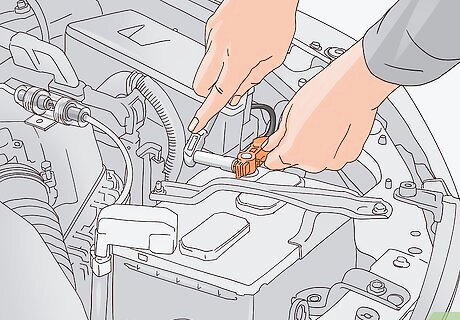
Reconnect the negative battery terminal to test the amplifier. Slide the negative terminal back onto the port on the battery and push it down as far as you can. Tighten the nut with a socket wrench to secure the terminal back to the battery so you’re able to use your vehicle again. Turn the key in the ignition to start your vehicle and check if the power light turns on for the amp. If you don’t see the power light turn on, shut off your vehicle and disconnect the negative terminal before checking all of the power connections.
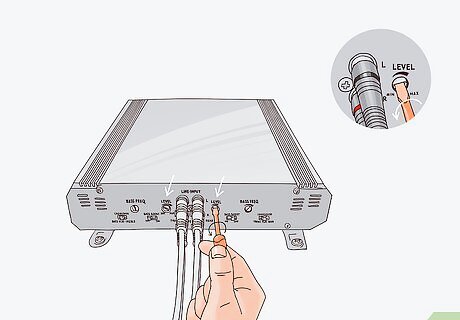
Turn the gain on the amp down as far as it can go. Look for a knob or screw that’s labeled “Gain” or “Amp Sensitivity” on the front of your amp. If there’s a knob, turn it counterclockwise by hand to lower the gain. If there’s a screw, turn it counterclockwise with a screwdriver until it doesn’t go any further. The gain controls how loud the amp will output the audio from your stereo.
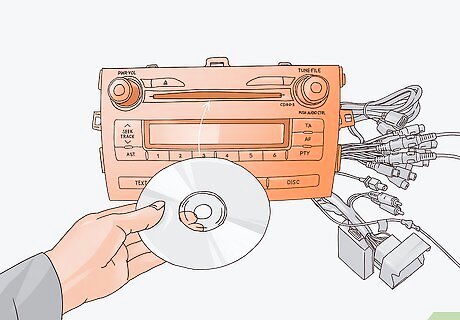
Play clean audio that you’re familiar with through your stereo. Put a CD in the stereo or connect an MP3 device so you can play music. Choose a song that you know well and has crisp, clear audio so you can hear distortion easily. Keep the song on repeat so you can continue listening for audio interference. You can also use the radio, but make sure the station comes in without any static, or else it can be hard to tell if it’s caused by the amp.
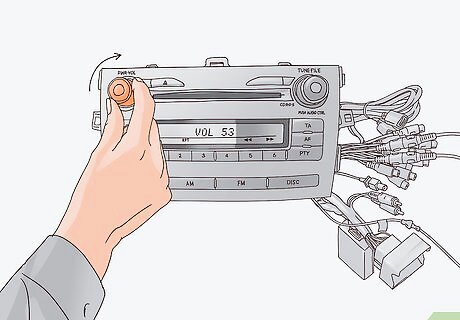
Raise the volume on the stereo head until you hear distortion. Turn the volume knob slowly on the stereo to increase the volume. Keep turning the dial until you hear static or interference coming through your speakers. Find the volume level right below where the distortion starts so you can adjust your vehicle’s audio accordingly. You won’t hear the music start playing yet since the speakers run through the amp and the gain is turned down.
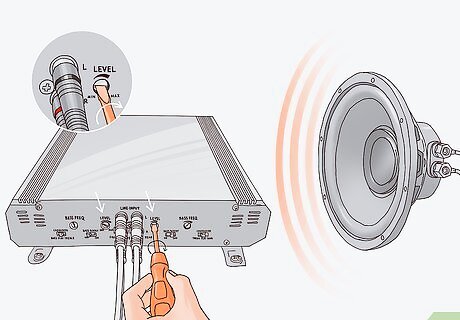
Set the gain controls until the music is as loud as you plan on listening to it. Rotate the gain control clockwise by hand or with a screwdriver so you can hear the audio through your speakers. Continue raising the gain setting until you have the audio as loud as you think you’ll play it in your vehicle. If you hear any distortion or interference, turn the gain down slightly until you don’t hear it anymore. Once you’re happy with the gain levels, turn the volume down at your stereo. Whenever you want to make volume adjustments after setting the gain, you can use the knob on the stereo head.
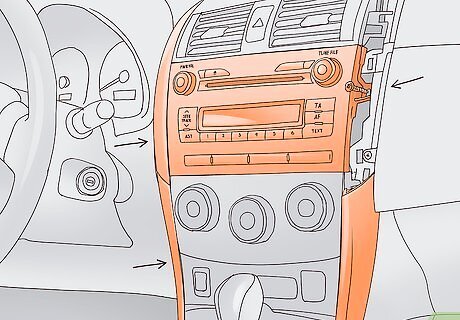
Reattach the trim pieces and stereo head when you’re finished. Push the wires for the stereo head back into the hole and position it so the mounting holes line up with the dashboard. Screw the stereo into the dashboard so it’s secure. Line up the trim panels around the stereo and on the sides of your vehicle and push them in until they snap into place. Keep attaching the rest of the trim pieces to finish the installation.




















Comments
0 comment